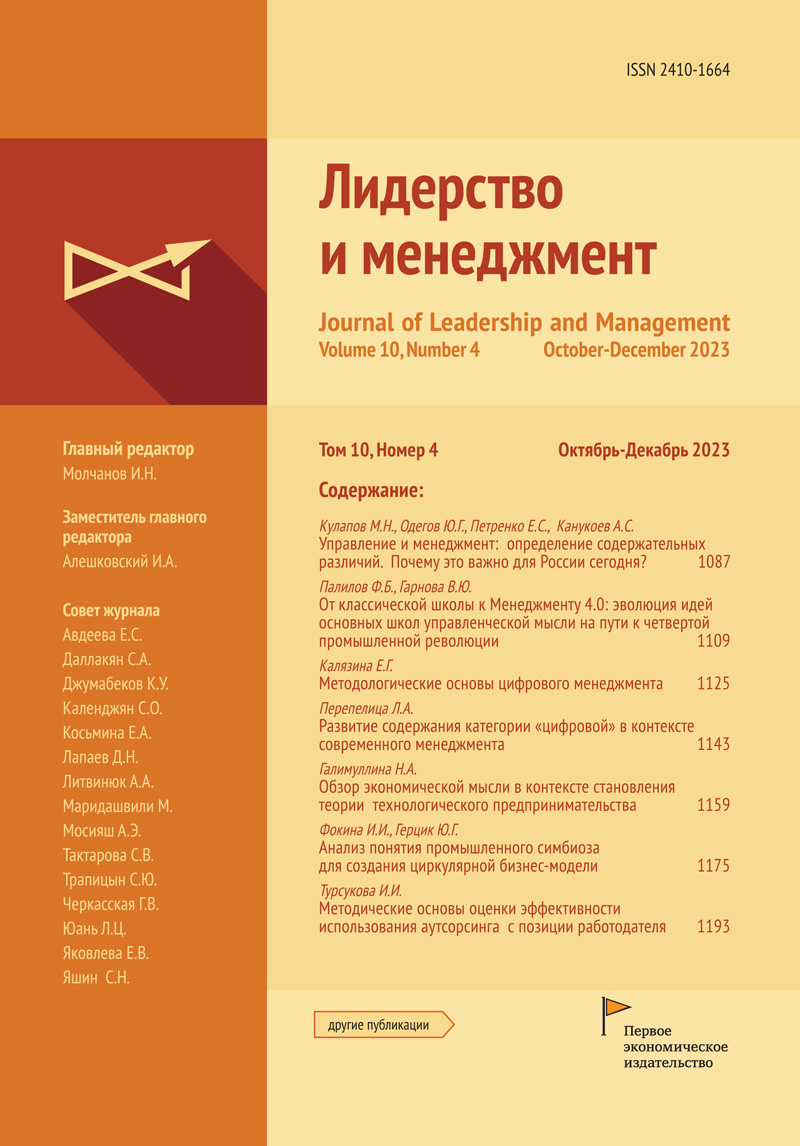System analysis of organizational culture typologies
- Autores: Zyabrikov V.V.1, Shevazutskiy I.R.1
-
Afiliações:
- St Petersburg State University
- Edição: Volume 10, Nº 4 (2023)
- Páginas: 1235-1254
- Seção: Articles
- URL: https://journals.eco-vector.com/2410-1664/article/view/625254
- DOI: https://doi.org/10.18334/lim.10.4.118828
- ID: 625254
Citar
Texto integral
Resumo
The existing typologies of organizational culture are divided into two groups: cluster (Harrison, Handy), based on the similarity of cultures with four fundamental types of culture (leader, bureaucrat, entrepreneur and professional) and criteria-based (Cameron and Quinn, Zyabrikov), built on the coordinate principle and based on competing values. It is shown that a number of typologies of organizational culture include similar types due to the fact that the criteria of organizational culture are actually not criteria, but characteristics of four fundamental types of culture.The authors demonstrate that according to the Cameron and Quinn's typology, each type of organizational culture corresponds to a pair of dominant roles of businessmen (one strategic and one operational). Taking into account the relationship between the type of organizational culture and the stage of the firm’s life cycle, it is argued that while optimizing the management of an organization, the aim should not be to reach a non-existent ideal firm but to successively change the models of the firm’s internal environment, matching the sequence of changing the types of organizational culture (leader, bureaucrat, entrepreneur and professional).
Sobre autores
Vladimir Zyabrikov
St Petersburg State University
Email: zyabrikov@mail.ru
Igor Shevazutskiy
St Petersburg State University
Email: shevazutckii_igor@mail.ru
Bibliografia
- Адизес И.К. Управление жизненным циклом корпорации. - СПб.: Питер, 2008. – 384 c.
- Виханский О.С., Наумов А.И. Менеджмент. / Учебник. – 3-е изд. - М.: Экономистъ, 2003. – 528 c.
- Грошев И.В., Емельянов П.В., Юрьев В.М. Организационная культура. / Учеб. пособие для студентов вузов. - Москва: ЮНИТИ-ДАНА, 2004. – 288 c.
- Зябриков В.В. Типология и эволюция организационной культуры // Проблемы современной экономики. – 2007. – № 4(24). – c. 194-200.
- Зябрикова А.В., Зябриков В.В. Развитие теории жизненного цикла на основе единой типологии деловой культуры // Проблемы современной экономики. – 2015. – № 1(53). – c. 116-120.
- Камерон К., Куинн Р. Диагностика и изменение организационной культуры:. / Пер. с англ. - СПб.: Питер, 2001. – 320 c.
- Коллинз Дж., Поррас Дж. Построенные навечно: Успех компаний, обладающих видением. / Пер. с англ. - М.: Манн, Иванов и Фербер, 2018. – 362 c.
- Куликова В.В., Бадаева И.А. Диагностика корпоративной культуры в организации // Карельский научный журнал. – 2022. – № 3(40). – c. 16-19. – doi: 10.57145/27129772_2022_11_03_04.
- Миклтуэйт Дж., Вулдридж А. Магия менеджмента. / Пер. с англ. Монография. - М.: АСТ, 2004. – 414 c.
- Мильнер Б.З. Теория организации. / Учеб. для студентов вузов, обучающихся по экон. спец. – 2-е изд. - М.: Инфра-М, 1999. – 478 c.
- Минцберг Г. Структура в кулаке: создание эффективной организации. / Пер. с англ. - СПб.: Питер, 2004. – 512 c.
- Минцберг Г., Альстрэнд Б., Лэмпел Дж. Школы стратегий. / Пер. с англ. - СПб.: Питер, 2000. – 336 c.
- Оуэн Дж. Голая правда о… менеджменте. / Пер. с англ. - М.: ФАИР-ПРЕСС, 2003. – 362 c.
- Порцева В.С. Связь организационной структуры и этапа жизненного цикла организации // StudNet. – 2020. – № 3. – c. 459-466.
- Тихомирова О.Г. Организационная культура: формирование, развитие и оценка. - М.: Инфра-М, 2020. – 151 c.
- Тощенко Ж. Элита? Кланы? Касты? Клики? Как назвать тех, кто правит нами? // Социологические исследования. – 1999. – № 11. – c. 123-133.
- Тромпенаарс Ф., Куберг П.Х. 100 ключевых моделей и концепций управления. - М.: Манн, Иванов и Фербер, 2019. – 640 c.
- Тромпенаарс Ф., Хэмпден-Тернер Ч. 4 типа корпоративной культуры. - Минск: Попурри, 2012. – 525 c.
- Чернова Е.В., Чернов Г.Е., Баженова Т.С. Практика применения диагностики корпоративной культуры в целях повышения эффективности функционирования организации // Общество: политика, экономика, право. – 2019. – № 2(67). – c. 16-24. – doi: 10.24158/pep.2019.2.2.
- Handy C. The Gods of Management. - New York: Penguin Books, 1978.
- Handy C. Understanding Organizations. / 4th ed. - New York: Penguin Books, 1993. – 448 p.
- Harrison R. Understanding your Organization’s Character // Harvard Business Review. – 1972. – p. 119-128.
- Quinn R.E., Cameron K. Organizational Life Cycles and Shifting Criteria of Effectiveness: Some Preliminary Evidence // Management Science. – 1983. – № 1. – p. 33-51. – doi: 10.1287/mnsc.29.1.33.
- Quinn R.E., Rohrbaugh J. A Spatial Model of Effectiveness Criteria: Towards a Competing Values Approach to Organizational Analysis // Management Science. – 1983. – № 3. – p. 363-377.
- Sathe V. Culture and Related Corporate Realities: Text, Cases and Reading on Organizational Entry, Establishment and Change. - Homewood, IL: Richard D. Irwin, 1985. – 579 p.
Arquivos suplementares









